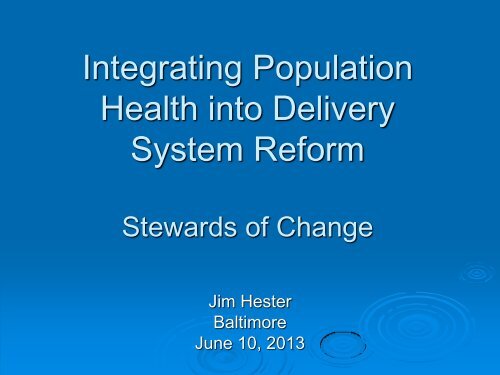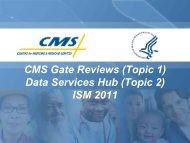SOC 2013 - Jim Hester - National Interoperability Community of ...
SOC 2013 - Jim Hester - National Interoperability Community of ...
SOC 2013 - Jim Hester - National Interoperability Community of ...
- No tags were found...
You also want an ePaper? Increase the reach of your titles
YUMPU automatically turns print PDFs into web optimized ePapers that Google loves.
Integrating PopulationHealth into DeliverySystem ReformStewards <strong>of</strong> Change<strong>Jim</strong> <strong>Hester</strong>BaltimoreJune 10, <strong>2013</strong>
I. ContextWhy Delivery System Reform?‣ Goal: Universal access to affordable, qualityhealth care for all‣ Issue: performance <strong>of</strong> existing system results inunsustainable costs‣ Approach: transformation <strong>of</strong> the current system toachieve and reward Triple Aims outcomes• Better health for populations• Better health care for those who need it• Lower total costs through improvement‣ Conceptual Model: Halfon, Healthcare 3.0
US Health Care Delivery System EvolutionHealth Delivery System Transformation Critical PathAcute Care System 1.0Coordinated SeamlessHealthcare System 2.0<strong>Community</strong> IntegratedHealthcare System 3.0Episodic Non-Integrated CareOutcomeAccountable Care<strong>Community</strong>IntegratedHealthcare• Episodic Health Care• Lack integrated care networks• Lack quality & cost performancetransparency• Poorly Coordinate Chronic CareManagement• Patient/Person Centered• Transparent Cost and Quality Performance• Accountable Provider Networks DesignedAround the patient• Shared Financial Risk• HIT integrated• Focus on care managementand preventive care● Healthy Population Centered● Population Health Focused Strategies● Integrated networks linked to communityresources capable <strong>of</strong> addressing psychosocial/economic needs● Population based reimbursement● Learning Organization: capable <strong>of</strong> rapiddeployment <strong>of</strong> best practices● <strong>Community</strong> Health Integrated● E-health and telehealth capable
II. Innovation in Payment Reform‣ Federal: CMS Innovation Center (CMMI)‣ State: Vermont Delivery System Reform
2011 Vision: CMS as a CatalystThe CMS MissionCMS is a constructive force and a trustworthypartner for the continual improvement <strong>of</strong>health and health care for all Americans.7
The Innovation CenterACA Charge (S 3021): Identify, Test, Evaluate, Scale“The purpose <strong>of</strong> the Center is to test innovative paymentand service delivery models to reduce programexpenditures under Medicare, Medicaid, andCHIP…while preserving or enhancing the quality <strong>of</strong> carefurnished.”• Resources: $10 billion funding for FY2011 through 2019• Opportunity to “scale up”: The HHS Secretary has theauthority to expand successful models to the national level8
Delivery TransformationDelivery Transformation ContinuumContinuumPartnershipfor PatientsInnovationChallengeComprehensivePrimary CareBundled PaymentACOs-Advance PaymentPioneerACOsProviders can choose from a range <strong>of</strong> caredelivery transformations and escalatingamounts <strong>of</strong> risk, while benefitting fromsupports and resources designed to spreadbest practices and improve care.Tools to Empower Learning and Redesign:Data Sharing, Learning Networks, RECs, PCORI, Aligned Quality StandardsPatient-CenteredSystem <strong>of</strong>the Future
Measures <strong>of</strong> SuccessBetter health care:Better health:Lower costs throughImprovement:Improving patients’ experience <strong>of</strong> care within the Institute<strong>of</strong> Medicine’s 6 domains <strong>of</strong> quality: Safety, Effectiveness,Patient-Centeredness, Timeliness, Efficiency, and Equity.Keeping patients well so they can do what they want todo. Increasing the overall health <strong>of</strong> populations: addressbehavioral risk factors; focus on preventive care.Lowering the total cost <strong>of</strong> care while improving quality,resulting in reduced expenditures for Medicare, Medicaid,and CHIP beneficiaries.10
Population Health at CMMICreate the Vision: Articulate a clear conceptual framework for evolution <strong>of</strong>health system built on national strategies for quality and prevention1. Measure• Develop robust set <strong>of</strong> measures for tracking changes in population health2. Test New Models <strong>of</strong> Payment and Service• Strengthen population health focus in all models• Identify and support innovations which integrate clinical care with community based focuson determinants <strong>of</strong> health3. Build Collaborations• State• Private payers• Federal Partners (e.g., CDC, AoA, HRSA, DOD)• Public health: e.g. ASTHO, NACCHO• Public/private coalitions4. Promote and Teach• Catalyst , exemplary case studies, IAP,11
Health Care Innovation Awards:Population HealthPopulation Health Portfolio• 21 awards for a total <strong>of</strong> $114 million• 12 awards managed by CDC program <strong>of</strong>ficers: team <strong>of</strong> program <strong>of</strong>ficers, subjectmatter experts and leadershipExamples <strong>of</strong> Themes <strong>of</strong> interventions• Diabetes cluster, eg multi-state large scale test <strong>of</strong> YMCA Diabetes PreventionProgram• <strong>Community</strong> based asthma prevention and care cluster, eg Nemours test inDelaware• <strong>Community</strong> based determinants <strong>of</strong> health ,eg MI Public Health Institutecommunity pathways, Chicago <strong>Community</strong> Rx• School healthRound 2 in process
VT Health Reform600,000 total populationGoal: improve the health <strong>of</strong>Vermonters13 Hospital Service Areasdefine ‘community systems’Payers: 3 commercial + 2publicLaboratory for healthreform13
III. Delivery System Reform andPopulation Health‣ Status‣ New population health financing models• Opportunities• Threats
Status: Growing Opportunity‣ Broad diffusion <strong>of</strong> language supporting betterhealth for populations,‣ New payment models being tested at scale‣ New options: Hospital community benefit,bank community reinvestment‣ Signs <strong>of</strong> initial regional markets aligning , egComprehensive Primary Care Initiative,‣ BUT, Delivery system evolution lags rhetoric,with broad distribution across Halfon’s scale• Laggards stuck in 1.0: It still works financially• Many working to achieve 2.0 at practice andcommunity levels• A very few exploring path to 3.0
Challenges for PopulationHealth Financial Models‣ Other dimensions <strong>of</strong> value (total cost, patientexperience) have a long history <strong>of</strong> being used inpayment models• Interventions better understood• Measures and instruments developed• Accountability more clear cut‣ Tasks associated with managing total cost andpatient experience are all consuming‣ Population health business case requiresreinvestment <strong>of</strong> shared savings from multiplesectors and valuing long term impacts 19
ChallengesImproving population health is intimidatinggoal• Determinants <strong>of</strong> health model not readilyunderstood: Tendency to focus on thefamiliar, clinical services that health providerscontrol directly.• Portfolio <strong>of</strong> validated interventions for key riskfactors eg obesity, is small• Measures are poor: Confusion betweenquality <strong>of</strong> care and population health, focus onclinical measures 20
ThreatPayment models for population health in early stage<strong>of</strong> development‣ Population health traditionally funded by grants,taxes, not payment for services‣ Infrastructure and tools for population healthimprovement are not well developed• Integrated service models for clinical care, publichealth and community based resources• Business case for payment models fundamentallydiifferent from impact on risk factors: CMS vs CDC• Robust measures for learning, accountability andpayment‣ Risk: new payment models will be established withno meaningful population health component
Theme: Recap‣ Health care system is transitioning from paymentbased on volume to value‣ Defining value based on Triple Aims outcomes couldcreate funding stream to reward improvements inpopulation health‣ The determinants <strong>of</strong> health imply integration <strong>of</strong> clinicalcare, public health and community services targetedon upstream determinants i.e., interoperability‣ A window <strong>of</strong> opportunity exists for population health toshift to more sustainable funding models‣ However, the complexity and relative weakness <strong>of</strong> keybuilding blocks required for payment models createsthe threat that population health will not beincorporated in new payment models in a meaningfulway



